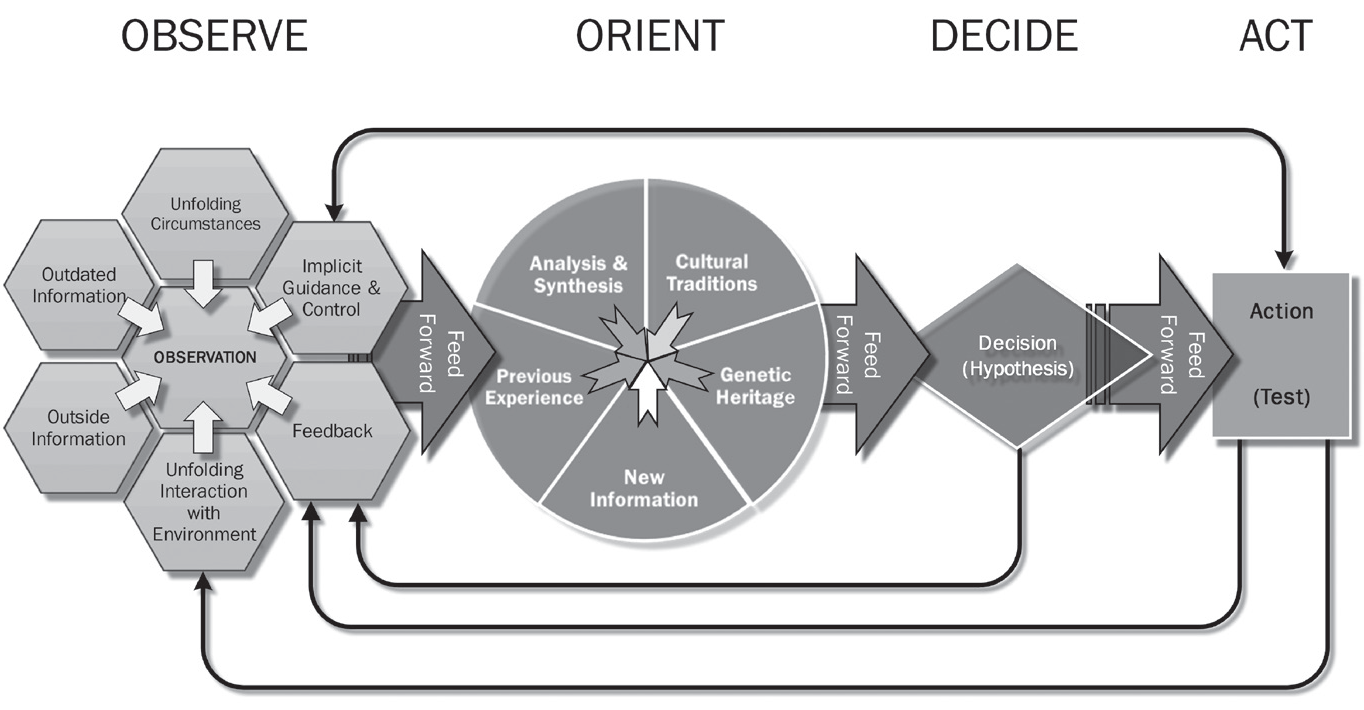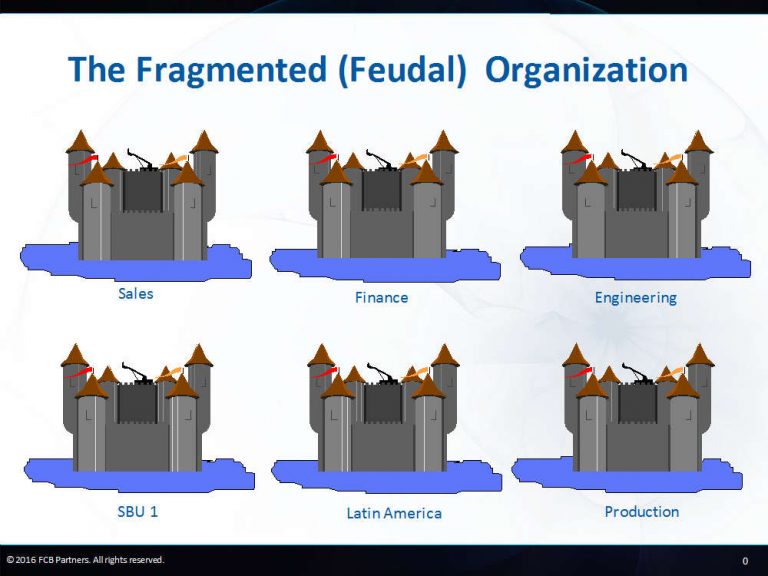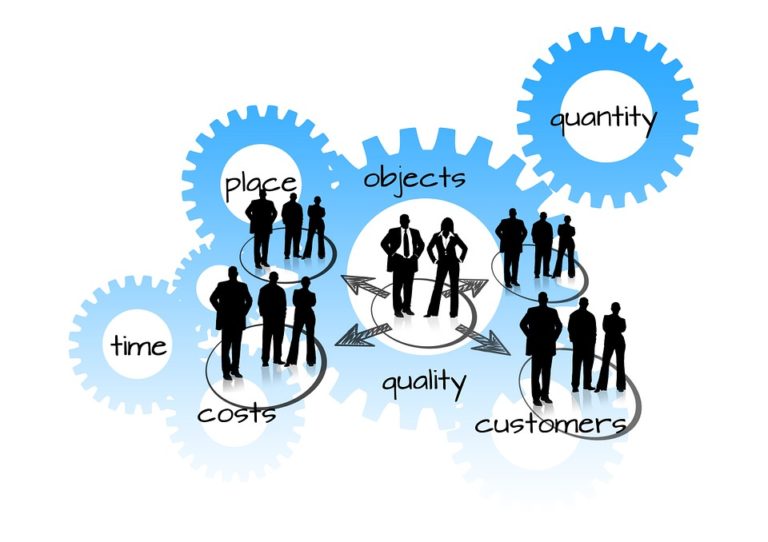OODA and Agility; Reaching a Conclusion Faster
Since the beginning of recorded history, great leaders of engagements have known two things; 1) Time is the enemy with speed and decisiveness in making a decision being an advantage and 2) there is no such thing as the perfect plan. Therefore the ability to adapt as circumstances unfold is critical to success.
Sun Tzu, a military strategist in the 6th century BC and known for his writings on military doctrine in “The Art of War”, recognized and understood the importance of speed and planning very well.
On speed; “Quickness is the essence of the war. Therefore, it is the nature of the army to stress speed.” Here, it is interesting to note that Sun Tzu refers to both “quickness” and “speed”, indicating he believed there was a difference. Most academics consider the reference to “quickness” as being about making a decision in a short amount of time and “speed” about being able to deploy that decision rapidly.
And on planning; “If you know the enemy and know yourself you need not fear the results of a hundred battles.”. In this quote, Sun Tzu understands the importance of understanding your capacity and capability – and what stands in your way of success which needs to be overcome (the enemy). It is important to note that Sun Tzu does not guarantee victory in each of the hundred battles, only that you need not fear their engagement because you will be successful in the end.
Separately and on the other side of the world; Plato, a Greek philosopher in the 4th century BC recognized that making a decision relies upon the combination of speed and planning. He is quoted as saying, “A good decision is based on knowledge and not on numbers,” in that knowledge will accelerate the making of a decision more-so than the collection and analysis of data.
As such, Plato recognizes that a decision is a wager, a bet, and that a good decision will depend upon knowledge – an understanding of the problem statement including the resources available and the circumstances of the situation. He also understood that data, while important, is less valuable than knowledge – that no amount of data collected and analyzed can guarantee an outcome. Rather, that data viewed through the eyes of someone knowledgeable and understanding of the context is important in making a good decision.
In the 1800’s, Helmuth von Moltke the Elder stated, “No plan of operations extends with any certainty beyond the first contact with the main hostile force”, which has often been paraphrased as, “No plan survives first contact with the enemy.” Here, von Moltke recognizes that plans cannot be considered static and unwavering because they will collapse almost immediately upon the start of their execution.
Dwight D. Eisenhower understood the frailty of a plan and that the importance of having a command of the planning process is what was most important when he said, “Plans are nothing. Planning is everything.” And Mike Tyson’s personalized adaptation of Eisenhower’s quote, “Everyone has a plan until they get punched in the mouth” made it so that everyone could grasp the concept.
Therefore, if all things are equal – in these examples, Eisenhower with his military resources and Tyson with his pugilistic talents – then time is the enemy. And the person (or organization) that understands what success is, can recognize opportunities and threats sooner, devise and deploy decisive responses faster, and understands that a successful conclusion will more likely be the result of iterative engagements made quickly rather than a single master-stroke, will have the better chance of realizing a successful conclusion. That making a decision sooner rather than later, or worse, not making a decision, will almost certainly result in peril or even doom.
This can be best summarized in a quotes from Theodore Roosevelt when he said, “In any moment of decision, the best thing you can do is the right thing, the next best thing is the wrong thing, and the worst thing you can do is nothing” and (my personal favorite) “Do what you can, with what you got, from where you are.”
The OODA Loop
Colonel John Richard Boyd, a fighter pilot in the United States Air Force, is credited with having conceived and developed the concept of the OODA-Loop in the 1950’s during the Korean War for gaining the advantage during aerial combat based on an iterative four-stage process: Observe, Orient, Decide, and Act. This is the OODA loop.
The premise and strength behind the OODA loop is the assumption that time is the dominant factor in engagement and decisions need to be made from imperfect data. The pilot who can engage the OODA loop in the shortest amount of time will have the advantage and will likely be victorious, because the opposition will be caught responding to circumstances that have already changed. A critical key to the OODA loop’s success as a decision-making method is the loop itself, which acts to guide and refine the decisions in a series of continuously improving outcomes.
The OODA loop’s simplicity and elegance in design and its effectiveness in use make it a popular decision-making method. It is especially well suited for decisions based on imperfect data. This is a key accelerant in the decision-making process and is especially advantageous during strategy execution.
In any engagement, speed is an advantage: speed in identifying an opportunity or threat, speed in formulating an action plan, speed in executing the action plan, speed in reacting to the changing dynamics during the execution phase, and speed in deciding to disengage when you are at an irrecoverable disadvantage (and knowing when that is). Paralysis by analysis will almost certainly precipitate a less than stellar result or even doom. Therefore, the key to success in an engagement will be you and your company’s execution of the OODA loop quicker than the opposition or, in the case of business, the competition.
And this will require an aggressive regimen of learning, practice, and application of the necessary skills—beyond those of your competitor—which will tilt the odds of success considerably in your favor. To maintain this edge, continual evaluation and revision of our strategies and tactics are crucial as technologies, conditions, capabilities, and circumstances evolve.
Let’s examine the stages of the OODA loop in greater detail.
Stage 1: Observe
The loop begins with observation. You must focus on external parameters and quickly filter what is important from what is not. This is your data collection stage. At this point, all of your senses should be heightened as you seek and absorb and evaluate all manner and forms of data. The more data you can collect, the more accurate your insight will be and the faster it can be absorbed and evaluated. Ask yourself the following questions:
- How might this primordial soup of data affect me?
- What’s happening that directly affects me?
- What’s happening that indirectly affects me?
- What’s happening that may have lingering effects later?
- What circumstances are developing?
- What are the present conditions?
Stage 2: Orient
Orienting is taking what you observe and formulating an approach. You analyze the data collected in the Observe stage and focus on your business’s internal condition and capabilities to assess your current reality. This is how you interpret a situation in advance of making a decision. Boyd recognized five main influences in transforming data into information:
- Cultural traditions
- Genetic heritage
- The ability to analyze and synthesize
- Previous experience
- New information coming in
The objective here is to increase the velocity and effectiveness of your movement through each successive trip around the OODA loop to arrive at a decision. This process is iterative; as you observe additional information, you will need to evaluate the impact with a balance of speed and accuracy and update your orientation accordingly.
Stage 3: Decide
Next, you must determine a course of action. Always keep in mind that, even if you have all the data in the world, decisions do not guarantee success; they’re just best guesses. Success or failure will be based on your capabilities, your experience, and the quality of your observations, orientations, and actions. Decisions are rather dynamic in nature and should be considered fluid works in progress. For every trip around the OODA loop, new data will be transformed into new information, driving new suggestions, creating opportunities to modify your decisions and to drive subsequent actions. Remember that a decision does not require you go with either plan A or plan B; discontinuing the determination is also a valid decision.
Stage 4: Act
The final stage in your trip around the OODA loop will be to execute your decision. Then, you immediately cycle back to the Observe stage after you evaluate the outcome. Making a decision and taking action will have an impact on the data you have observed, which drives the information you’ve created and influences the decisions you have made. Therefore, the loop perpetuates until the opportunity is fully resolved by either completion or disengagement.

The OODA loop is not like a checklist; rather, it’s a smooth, continuous, and dynamic process with an emphasis on training, experience, and wisdom to determine an action. The objective is to move through each stage as quickly as possible while maintaining a high degree of quality—quicker and better than your opponent. Considering this, it should be obvious that to take the time to map out each step and create a sort of standard operating procedure would slow down your progression through the OODA loop. But be cautious when emphasizing speed.
Generally speaking, speed results from less data being collected and analyzed, so the information on which decisions are based is less reliable. The key to repeated success is to learn to balance the amount of information required against the speed necessary to maintain an advantage and the consequences of a poor decision.
The objective and strategic advantage of the OODA loop is the increase in velocity of decisions. It also increases speed in subsequent OODA cycles, as new data is collected and new information is formed. If the OODA cycles are performed quickly enough, you can command the tempo and direction of the engagement, force your competition to react to you instead of you reacting to them, and give yourself the clear advantage.
The macro-level decisions that are made quickly from imperfect data by employing the OODA loop precipitate ever-smaller tasks and subtasks—each with their own desired outcomes but all in alignment with and in support of the top-level strategy. As the granularity of the tasks increases, the variants and variables will decrease. The result will be an increase in the volume of data that can be collected and analyzed.
Agile project management
Agile is a method of project development that relies upon smaller, iterative steps than on a master project plan. Similar to the OODA loop, it assumes that the final outcome is not known in absolute terms at the beginning but will be discovered through the completion of a series of activities that will incrementally progress the development to its conclusion. In essence, the Agile approach is making decisions from imperfect data with the expectation that the outcomes desired will be achieved as they become more defined with each iteration.
Although incremental improvements to the approach of software development have existed since software existed, such as “iterative and incremental software development” and “rapid application development”, it wasn’t until Agile was established as a framework that the strategic development and tactical deployment became codified and the efforts aligned.
The origins of the Agile methodology, at least its formalization as a methodology, is largely credited to a meeting of computer software engineers and programmers sympathetic to the need for an alternative to documentation driven, heavyweight software development and included representatives from Extreme Programming, SCRUM, DSDM, Adaptive Software Development, Crystal, Feature-Driven Development, and Pragmatic Programming.
As far as “manifestos” are concerned, the “Manifesto for Agile Software Development” it is rather light on the content and simply reads;
“We are uncovering better ways of developing software by doing it and helping others do it. Through this work we have come to value:
- Individuals and interactions over processes and tools
- Working software over comprehensive documentation
- Customer collaboration over contract negotiation
- Responding to change over following a plan”
With the “Principles behind the Agile Manifesto” being;
- Our highest priority is to satisfy the customer through early and continuous delivery of valuable software.
- Welcome changing requirements, even late in development. Agile processes harness change for the customer’s competitive advantage.
- Deliver working software frequently, from a couple of weeks to a couple of months, with a preference to the shorter timescale.
- Business people and developers must work together daily throughout the project.
- Build projects around motivated individuals. Give them the environment and support they need and trust them to get the job done.
- The most efficient and effective method of conveying information to and within a development team is face-to-face conversation.
- Working software is the primary measure of progress.
- Agile processes promote sustainable development. The sponsors, developers, and users should be able to maintain a constant pace indefinitely.
- Continuous attention to technical excellence and good design enhances agility.
- Simplicity – the art of maximizing the amount of work not done – is essential.
- The best architectures, requirements, and designs emerge from self-organizing teams.
- At regular intervals, the team reflects on how to become more effective, then tunes and adjusts its behavior accordingly.
Since its origins in the development of software, Agile has evolved to be an overarching approach to design and development outside software development and is now used pervasively across industries; wherever development might occur.
People and organizations have always tried to achieve a balance between speed and flexibility of design with a predictability and control (accountability) of the deployment. This is why the most successful approaches are prescriptive, but not rigid.
The OODA loop was introduced in the 1950s, and Agile was introduced in the early 2000s. But each favors speed and being nimble over complexity and brawn.
Ty Cobb said, perhaps with deference to Sun Tzu, “Speed is a great asset; but it’s greater when it’s combined with quickness – and there’s a big difference.” In this, he meant that speed of strategy deployment is important, but there also needs to exist the ability to change the tactics as circumstances change – or are discovered.
The risks to Agile are the same as are with Lean and Six Sigma – that form becomes more important than substance – that the tools and techniques (the “what” and the “how”) become more important than goals (the “why”).
As professional leaders who are working in teams to achieve a result, we need to remain focused on creating the outputs desired in a dynamic environment, and less so on the inputs required.
About the author

Paris is the Founder and Chairman of the XONITEK Group of Companies; an international management consultancy firm specializing in all disciplines related to Operational Excellence, the continuous and deliberate improvement of company performance AND the circumstances of those who work there – to pursue “Operational Excellence by Design” and not by coincidence.
He is also the Founder of the Operational Excellence Society, with hundreds of members and several Chapters located around the world, as well as the Owner of the Operational Excellence Group on Linked-In, with over 60,000 members. Connect with him on LinkedIn or find out more about him.





